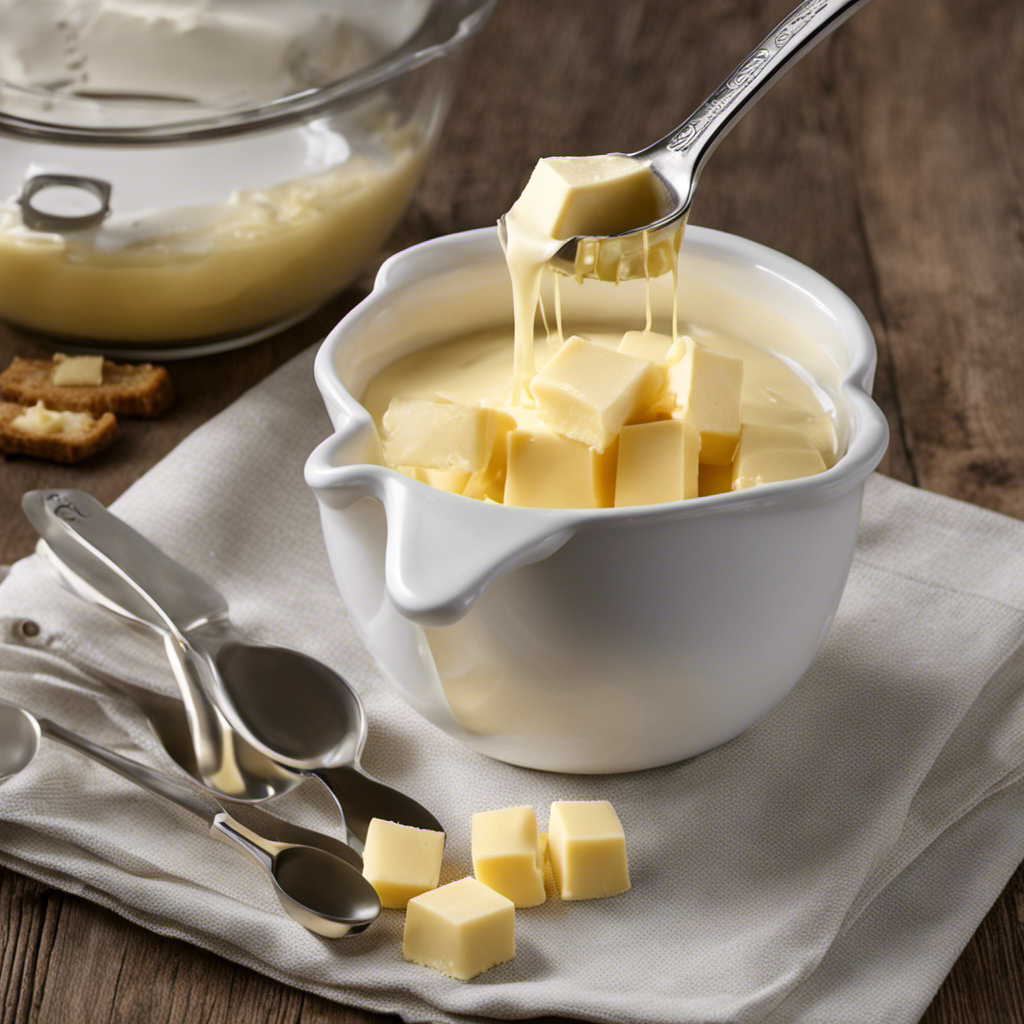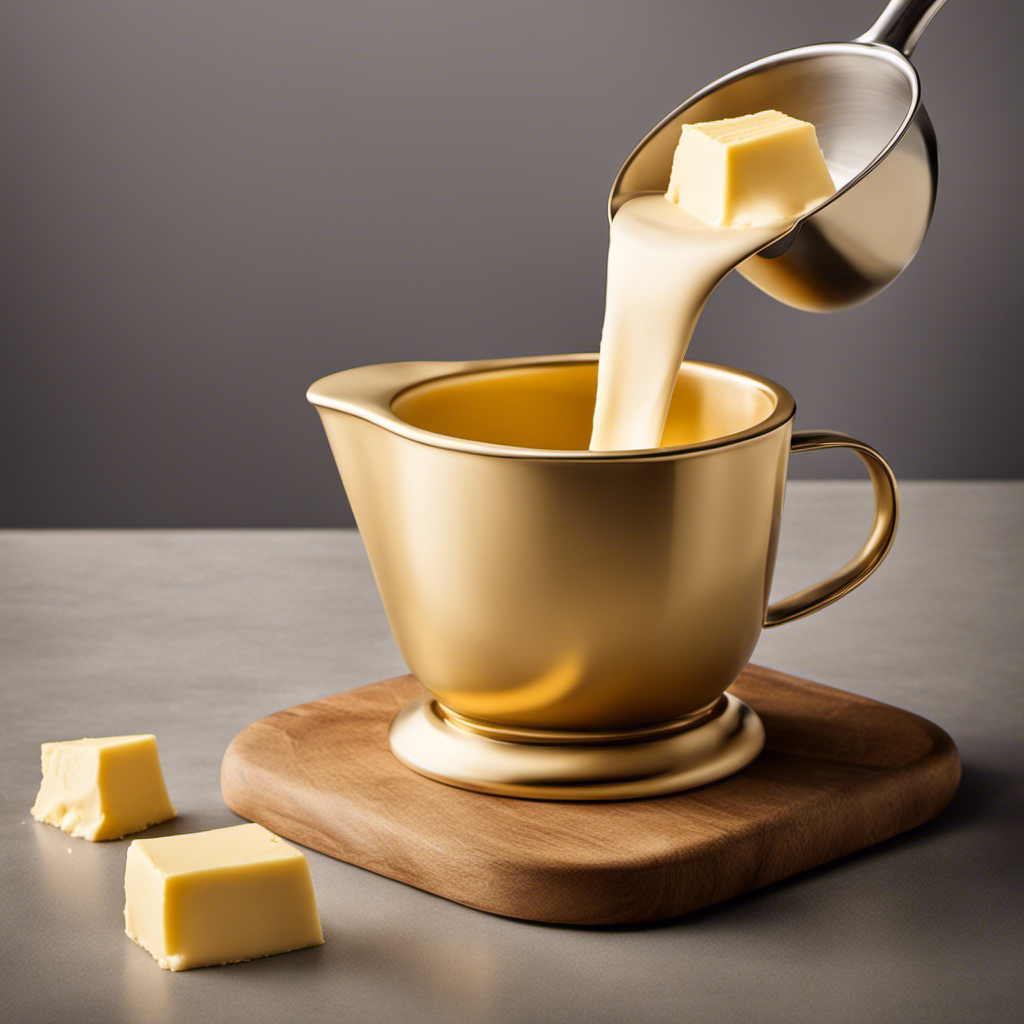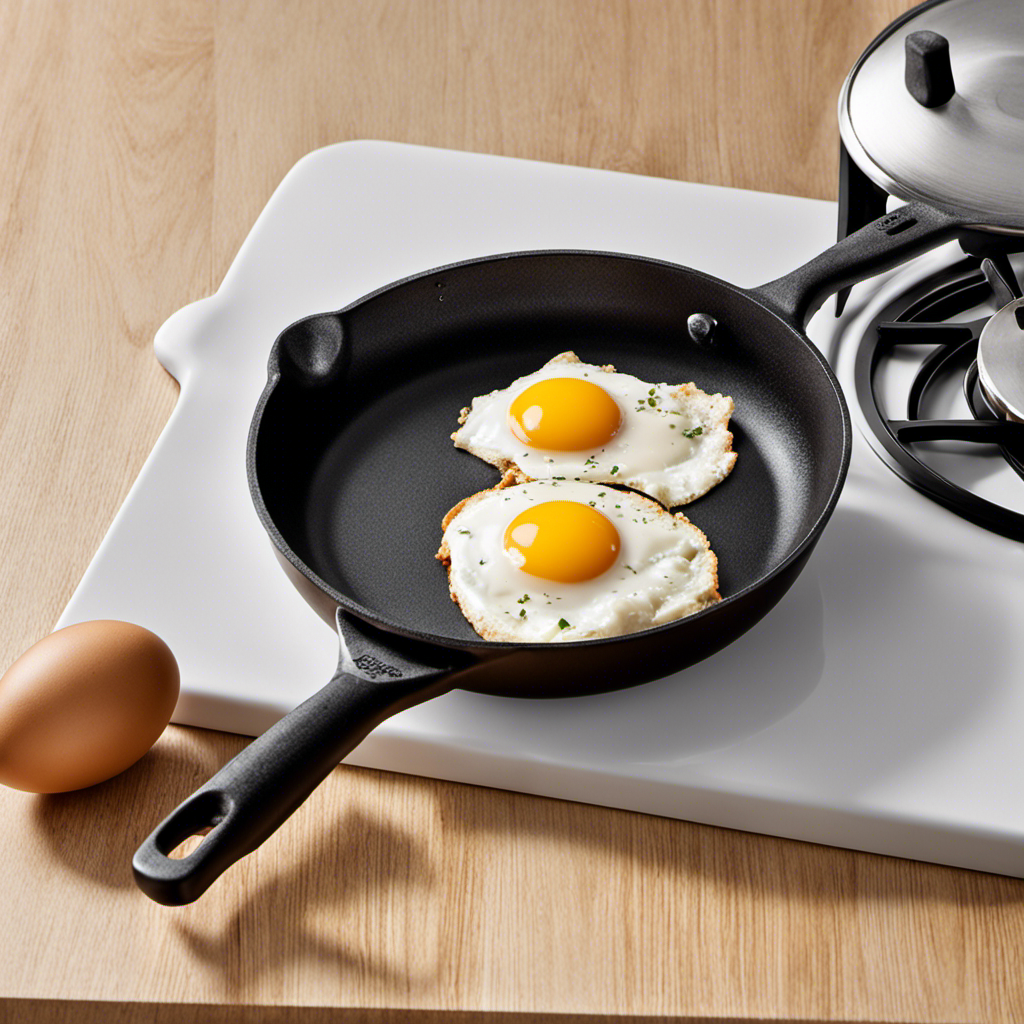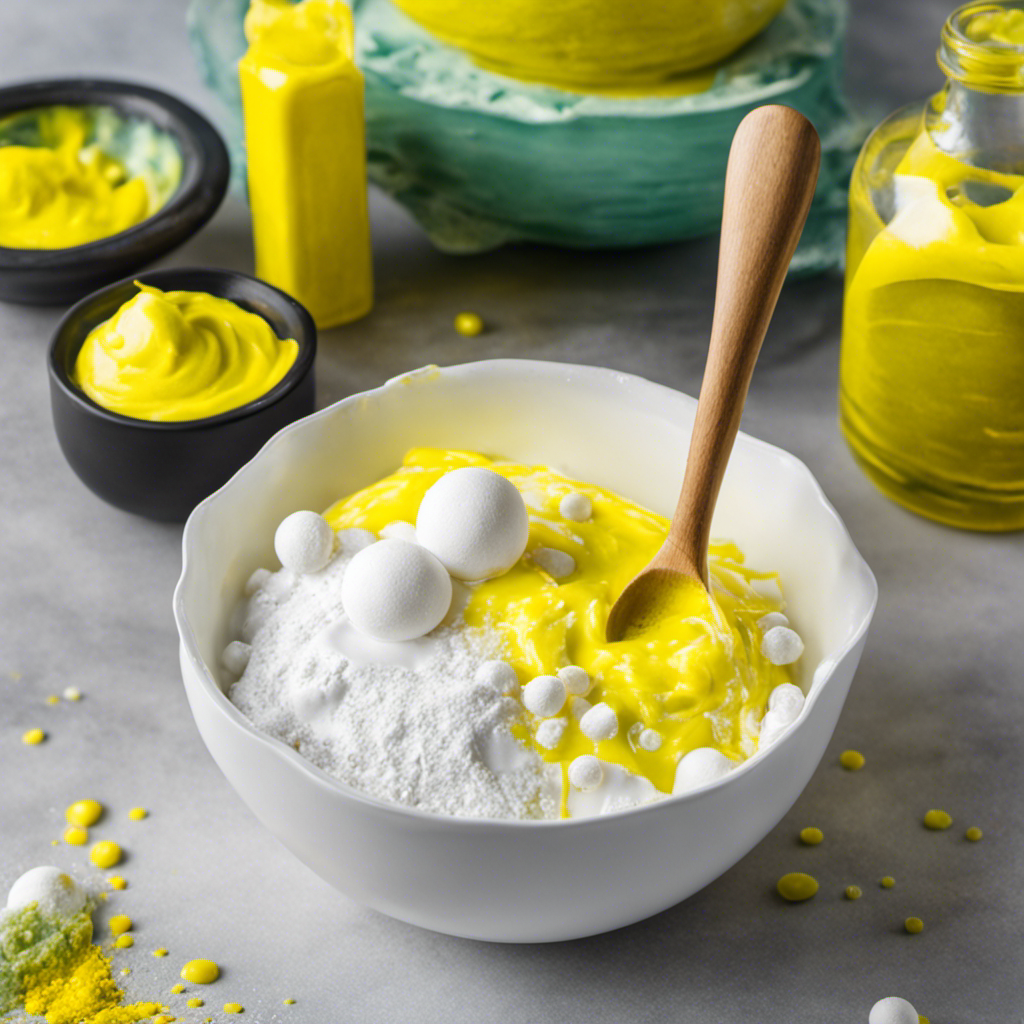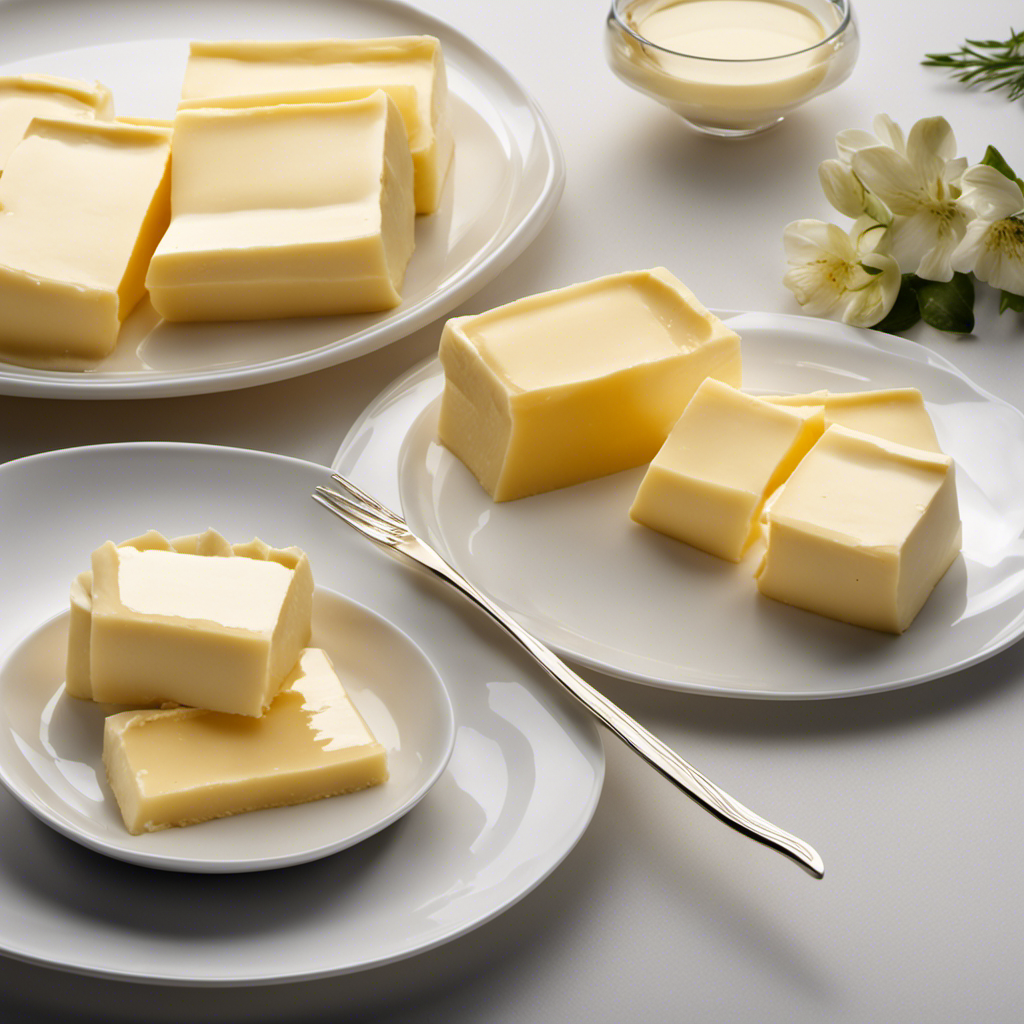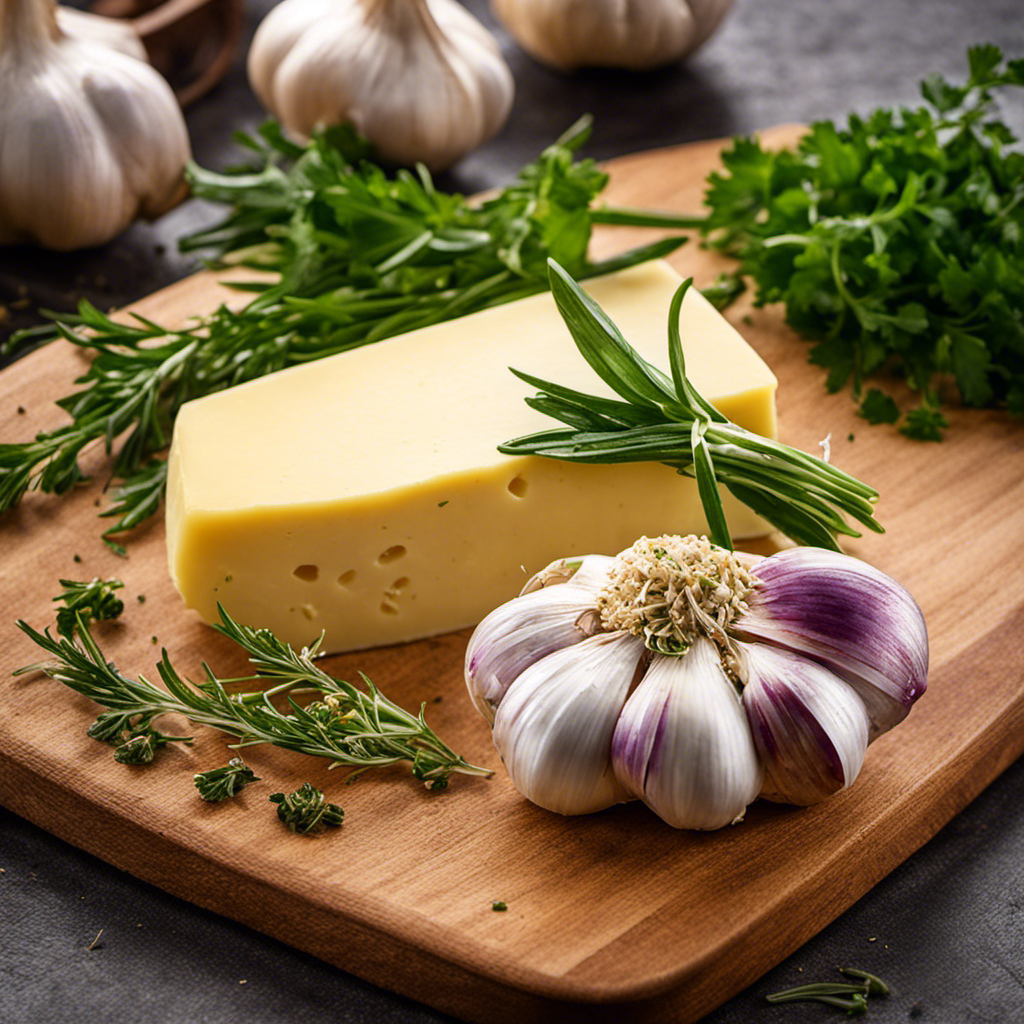As a food scientist, I am always fascinated by the variety of measurements and conversions in the culinary field. A common query is how many ounces are in a cup of butter. This apparently straightforward question can result in numerous misunderstandings and errors if not handled accurately.
In this article, I will guide you through the accurate and precise measurements of butter, exploring different packaging and providing tips and tricks for measuring butter for baking. So let’s delve into the world of butter measurements and demystify the ounces in one cup dilemma.
Key Takeaways
- 1 cup of butter is equal to 8 ounces.
- Butter is denser than liquid, so the conversion is based on weight rather than volume.
- Proper storage of butter is important for maintaining freshness and quality.
- Margarine, coconut oil, or applesauce can be used as substitutes for butter.
Understanding the Measurement of Butter
Do you know how many ounces are in 1 cup of butter? As a food scientist, I can provide accurate and precise information on this topic.
When it comes to measurement equivalents, 1 cup of butter is equal to 8 ounces. It’s important to understand these conversions to ensure the proper amount of butter in your recipes.
Now let’s talk about proper butter storage. To maintain its freshness and quality, it is recommended to store butter in the refrigerator. However, if you plan to use it within a few days, leaving it at room temperature is acceptable. Just make sure to keep it in an airtight container to prevent it from absorbing any odors from the surroundings.
These simple practices will help you enjoy the full flavor and texture of your butter.
Converting Cups to Ounces: The Basics
To convert cups to ounces, you’ll just need to remember the basic conversion. One cup is equal to 8 fluid ounces. However, when it comes to measuring butter, the conversion is a little different. Butter is denser than liquid, so the conversion is based on weight rather than volume. One cup of butter is equal to 8 ounces or 227 grams. Here is a helpful table to understand the conversions:
| Cups | Ounces | Grams |
|---|---|---|
| 1 | 8 | 227 |
| 1/2 | 4 | 113 |
| 1/4 | 2 | 57 |
| 1/8 | 1 | 28 |
| 1/16 | 0.5 | 14 |
The Standard Measurement for Butter in Cups
The standard measurement for butter in cups is different from the conversion for liquid ingredients. As a food scientist, I can provide accurate and precise information on this topic.
When it comes to butter, it is important to understand its composition. Butter is made up of fat, water, and milk solids. This composition affects its measurement in cups. One cup of butter is equal to 2 sticks or 16 tablespoons. However, it is essential to note that the weight of butter may vary depending on its density and temperature.
If you’re looking for substitutes for butter, there are options such as margarine, coconut oil, or applesauce. These alternatives can be used in recipes, but keep in mind that they may alter the taste and texture of the final product.
Exploring Different Butter Packaging
When exploring different packaging options, it’s important to consider factors such as convenience, freshness, and sustainability.
As a food scientist, I can provide accurate and precise information about alternative butter packaging options.
One option is the use of tubs or containers, which provide convenience and ease of use for spreading butter.
Another option is butter sticks, which are individually wrapped and allow for precise measurements when baking or cooking.
Additionally, some brands offer butter in resealable packages, ensuring freshness and reducing waste.
It’s worth mentioning that sustainable packaging, such as compostable or recyclable materials, is becoming more popular among consumers.
Overall, when choosing a butter brand, it’s important to consider not only the taste and quality but also the packaging options available to meet your specific needs and values.
How to Convert Ounces to Cups for Butter
Converting ounces to cups for butter is a simple process that can be done using a basic conversion factor. As a food scientist, I can provide you with precise and accurate information regarding this topic.
Here’s how you can convert butter measurements from ounces to cups:
- Start by knowing the conversion factor: 1 cup of butter is equal to 8 ounces.
- Divide the number of ounces you have by 8 to get the equivalent in cups.
- For example, if you have 16 ounces of butter, divide 16 by 8 to get 2 cups.
Converting butter measurements is essential for accurate recipe preparation. By understanding the butter measurement equivalents, you can ensure that your baked goods or dishes turn out just right. Remember to always use a reliable conversion chart or calculator for precise results.
Converting European Butter Measurements to Cups
When it comes to baking, accurate measurements are key.
Converting European butter measurements to cups can be a challenge, but fear not!
With the help of a butter conversion chart, simplifying these measurements becomes a breeze.
In this discussion, I will provide you with clear and concise information on how to convert European butter measurements to cups, ensuring that your baking endeavors are a success.
Butter Conversion Chart
To easily determine measurements, consult a butter conversion chart for the number of ounces in one cup.
As a food scientist, I understand the importance of accurately measuring ingredients, especially when it comes to butter.
Here are three key points to keep in mind when measuring butter accurately:
-
Butter packaging options: Butter is commonly sold in sticks, which are conveniently marked with measurements on the wrapper. Each stick is typically 4 ounces or 1/2 cup. Alternatively, butter can also be purchased in bulk, where you will need to measure it using a scale or conversion chart.
-
Measuring butter precisely: When a recipe calls for a specific amount of butter in cups, it’s crucial to convert ounces to cups accurately. One cup of butter equals 8 ounces or 226 grams. Ensure you have the correct measurements to achieve the desired outcome in your recipe.
-
Using a butter conversion chart: A butter conversion chart is a handy tool for quickly converting between ounces and cups. It provides precise measurements, leaving no room for confusion or inaccuracies. Keep it in your kitchen for easy reference and accurate measurements.
Simplifying European Butter Measurements
Now that we have a better understanding of the butter conversion chart, let’s dive into simplifying European butter measurements.
Converting European butter measurements can be a bit tricky, as they are often listed in grams or milliliters rather than the standard American cups or ounces. To simplify European baking, it is helpful to have a conversion chart handy that provides accurate measurements for butter in both grams and ounces. This allows for seamless substitution when following recipes from different regions.
By having these conversions readily available, you can easily adapt European recipes to your preferred measurement system, making it easier to recreate delicious treats from around the world. Understanding these conversions opens up a world of culinary possibilities.
Speaking of measurements, let’s now move on to the next section: measuring butter for baking, where I’ll share some tips and tricks to ensure precision in your recipes.
Measuring Butter for Baking: Tips and Tricks
If you’re baking and need to measure butter, remember that there are 8 ounces in 1 cup. When it comes to measuring butter for baking, it’s important to understand the difference between weight and volume. While 1 cup of butter weighs 8 ounces, it may not always be practical to measure butter by weight.
Here are some alternative measurements for butter in baking:
- Tablespoons: 1 stick of butter is equivalent to 8 tablespoons or 1/2 cup.
- Grams: 1 cup of butter is approximately 227 grams.
- Cubes: You can also measure butter in cubes. 1 stick of butter is equal to 4 cubes.
It’s essential to be knowledgeable about these measurements to ensure accuracy in your baking. Whether you choose to measure butter by weight or volume, these alternative measurements provide flexibility and convenience in the kitchen.
Happy baking!
Common Mistakes When Measuring Butter
One common mistake when measuring butter is not understanding the difference between weight and volume. As a food scientist, I can provide accurate and precise information to help you measure butter accurately. To avoid confusion, it’s essential to know that butter is typically measured by weight, not volume. Here’s a helpful table to understand the conversions:
| Measurement | Weight (ounces) |
|---|---|
| 1 tablespoon | 0.5 |
| 1/4 cup | 4 |
| 1/2 cup | 8 |
| 1 cup | 16 |
| 1 pound | 32 |
Frequently Asked Questions
Can I Use Margarine Instead of Butter in Recipes That Call for Cups of Butter?
Yes, you can use margarine as a substitute for butter in recipes. However, there may be a slight taste difference in baking. Margarine has a higher water content, which can affect the texture and flavor of the final product.
How Do I Measure Solid Sticks of Butter for Recipes That Call for Cups of Butter?
To measure solid sticks of butter for recipes that call for cups of butter, simply use a kitchen scale or refer to a conversion chart. This ensures accurate measurements and avoids any confusion.
Is There a Difference in Measurement Between Salted and Unsalted Butter When Converting Cups to Ounces?
Yes, there is a difference in measurement between salted and unsalted butter when converting cups to ounces. The type of butter can affect the taste and texture of the recipe.
Can I Use a Kitchen Scale to Measure Butter in Ounces Instead of Using Cups?
Using a kitchen scale for measuring butter ensures accuracy. Converting butter measurements from cups to grams is precise with a scale. As a food scientist, I provide clear and concise information, leaving no room for confusion.
Are There Any Alternative Measurements for Butter Apart From Cups and Ounces?
There are alternative forms of measurement for butter besides cups and ounces. Converting butter measurements for international recipes may require using grams or tablespoons, depending on the specific conversion chart or recipe.
Conclusion
In conclusion, understanding the correct measurements and conversions for butter is essential for any culinary enthusiast. With precise information and accurate conversions, there is no room for confusion or inaccuracies.
By providing clear and concise explanations, readers can easily grasp the topic at hand. As knowledgeable food scientists or culinary experts, we aim to offer valuable insights and educate our readers about the subject matter.
So, next time you’re in the kitchen, remember to measure your butter accurately and confidently. Can you envision the perfect baked goods that will result from your precise measurements?
